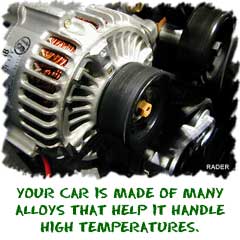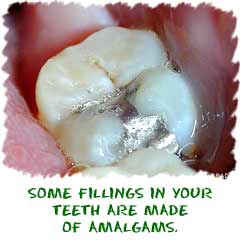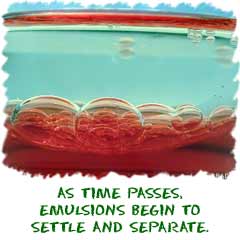
Alloys
 There are a few more words you might hear when people talk about mixtures. We can't cover all of them, but we'll give you a quick overview of the biggies. Alloys are basically a mixture of two or more metals. Don't forget that there are many elements on the periodic table. Elements like calcium (Ca) and potassium (K) are considered metals. Of course, there are also metals like silver (Ag) and gold (Au). You can also have alloys that include small amounts of non-metallic elements like carbon (C). Metals are the key thing to remember for alloys.
There are a few more words you might hear when people talk about mixtures. We can't cover all of them, but we'll give you a quick overview of the biggies. Alloys are basically a mixture of two or more metals. Don't forget that there are many elements on the periodic table. Elements like calcium (Ca) and potassium (K) are considered metals. Of course, there are also metals like silver (Ag) and gold (Au). You can also have alloys that include small amounts of non-metallic elements like carbon (C). Metals are the key thing to remember for alloys.
The main idea with alloys is that the combinations work better together than any of the metals do alone. Metallurgists (people who work with metals) sometimes add chromium (Cr) and/or nickel (Ni) to steel. While steel is already an alloy that is a very strong metal, the addition of small amounts of the other metals help steel resist rusting. Depending on what element is added, you could create Stainless Steel or Galvanized Steel. It's always about improving specific qualities of the original. Another good example of an alloy happens when metallurgists add carbon to steel. A tiny amount of carbon (a non-metallic element) makes steel stronger. These special carbon-steel alloys are used in armor plating and weapons.
Amalgams
 Amalgams are a special type of alloy. We like them because we think mercury (Hg) is a cool element. You might know mercury as "quicksilver" or the metal that is liquid at room temperature. Anyway, amalgams are alloys that combine mercury and other metals in the periodic table. The most obvious place you may have seen amalgams is in old dental work. The fillings in the mouths of your grandparents may have been amalgams. We already talked about mercury being a liquid at room temperature. That physical trait was an advantage when they made fillings. Let's say you have an amalgam of mercury and silver (Ag). When it is created, it is very soft. As time passes, the mercury leaves the amalgam and the silver remains. The silver left over is very hard. Voila! You have a filling!
Amalgams are a special type of alloy. We like them because we think mercury (Hg) is a cool element. You might know mercury as "quicksilver" or the metal that is liquid at room temperature. Anyway, amalgams are alloys that combine mercury and other metals in the periodic table. The most obvious place you may have seen amalgams is in old dental work. The fillings in the mouths of your grandparents may have been amalgams. We already talked about mercury being a liquid at room temperature. That physical trait was an advantage when they made fillings. Let's say you have an amalgam of mercury and silver (Ag). When it is created, it is very soft. As time passes, the mercury leaves the amalgam and the silver remains. The silver left over is very hard. Voila! You have a filling!
 NOTE: Never, ever, play with mercury! It is very poisonous. You shouldn't even touch it, because it will seep into your skin. Dentists don't usually use amalgams with mercury anymore, because some scientists think the mercury can get people sick. When there was extra mercury left in the fillings, it could seep into the blood stream. Most of you will never even have silver fillings. Many dentists use resin fillings, which are made up of plastic and very fine particles of glass.
NOTE: Never, ever, play with mercury! It is very poisonous. You shouldn't even touch it, because it will seep into your skin. Dentists don't usually use amalgams with mercury anymore, because some scientists think the mercury can get people sick. When there was extra mercury left in the fillings, it could seep into the blood stream. Most of you will never even have silver fillings. Many dentists use resin fillings, which are made up of plastic and very fine particles of glass.
Emulsions
Let's finish up with a little information on emulsions. These special colloids (another type of mixture) have a mixture of oils and waters. Think about a bottle of salad dressing. Before you mix it, there are two separate layers of liquids. When you shake the bottle, you create an emulsion. As time passes, the oil and water will separate, because emulsions are mixtures.More on Mixtures from Part I...
Related Video...
Gas Monitoring Tracks Volcanic Activity (USGS Video)



